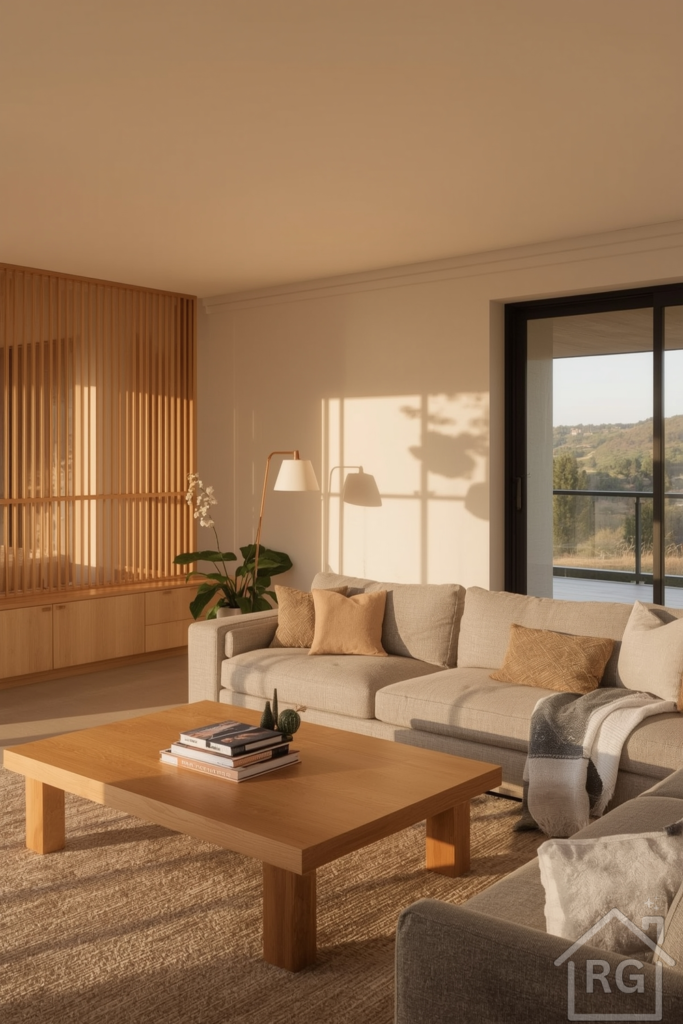
I. Introduction
Japandi marries the understated elegance of Japanese wabi-sabi with the cozy functionality of Scandinavian hygge, creating interiors that feel both calming and welcoming. In today’s fast-paced world, this design approach offers a respite—a place where clean lines, natural materials, and a muted palette restore balance and clarity. Whether you’re embarking on a full remodel or simply refreshing a corner of your home, this guide will equip you with the core philosophies, practical examples, styling insights, and pitfalls to avoid. Let’s explore how to bring harmony and warmth into your living spaces, transforming them into serene sanctuaries that nourish the body and soul.
II. What Is Japandi Style?

Japandi is more than a trend—it’s a philosophy rooted in simplicity, mindfulness, and a deep respect for craftsmanship. It draws on two cultural traditions:
- Wabi-sabi, the Japanese practice of embracing imperfection and transience. You’ll notice this in raw wood edges, subtly irregular ceramics, and surfaces that age gracefully.
- Hygge, the Danish art of creating warmth and comfort. Soft textiles, glowing candles, and communal gathering spaces foster well-being and connection.
When blended, these elements yield spaces that are pared back yet soulful, functional yet inviting. Japandi interiors prioritize quality over quantity, allowing each piece—be it a hand-thrown vase or an oak bench—to speak for itself. Neutral backgrounds of off-white, warm grey, and pale wood let textures and form take center stage, while intentional layouts ensure a seamless flow of light and life. In an era of constant distraction, Japandi beckons us to slow down, to surround ourselves with only what we truly need and love.
Color Palette

A Japandi color scheme whispers rather than shouts. Begin with a foundation of warm whites or soft ivory on walls and ceilings, allowing light to bounce gently throughout the room. Underfoot, pale oak or bleached wood floors anchor the space without overpowering it. Layer in soft greys, muted beiges, and touches of charcoal or deep clay to introduce subtle contrast—think a charcoal throw pillow on a linen sofa or a clay-toned vase atop a light wood shelf. The key is harmony: each hue should feel as though it belongs, creating a seamless, soothing environment free from jarring pops of color.
Materials & Textures
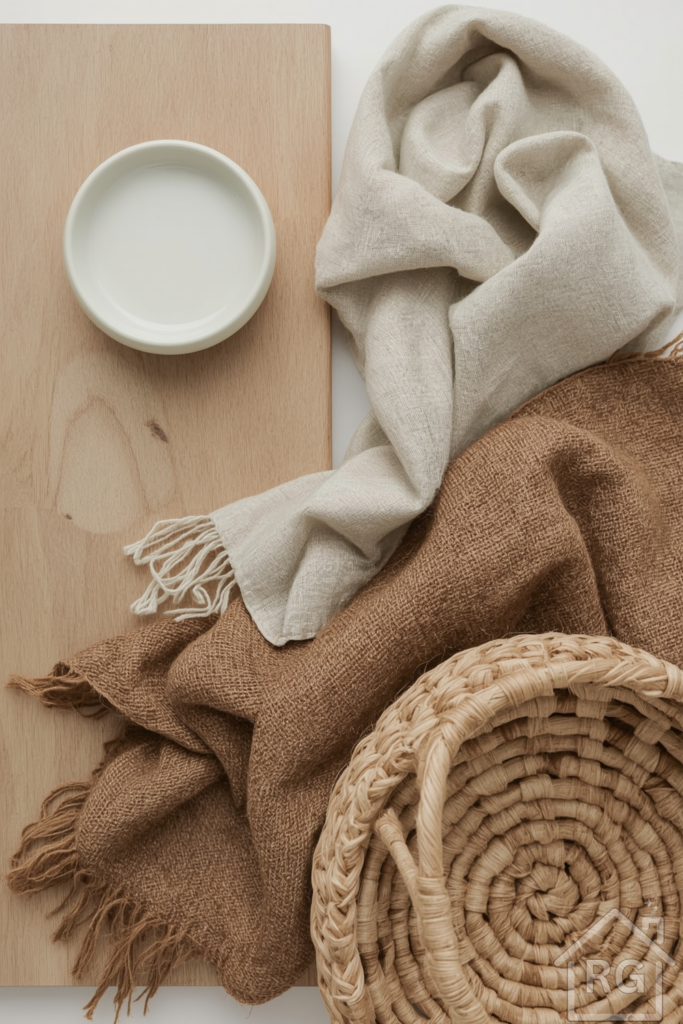
Japandi breathes life through its tactile materials. Linen drapes, with their gentle creases, filter light softly; woolen throws offer plush comfort and depth. Unfinished oak or ash surfaces showcase natural grain patterns and gradual patina. Cool, honed stone countertops or sink surrounds bring a grounding solidity, while hand-thrown ceramics—glazed just enough to reveal fingerprints—embody craftsmanship. Layer these textures thoughtfully: a coarse jute rug beneath a smooth wooden bench, a polished ceramic bowl resting on raw timber. Together, they form a multisensory dialogue that elevates minimalism into an immersive, comforting experience.
Furniture
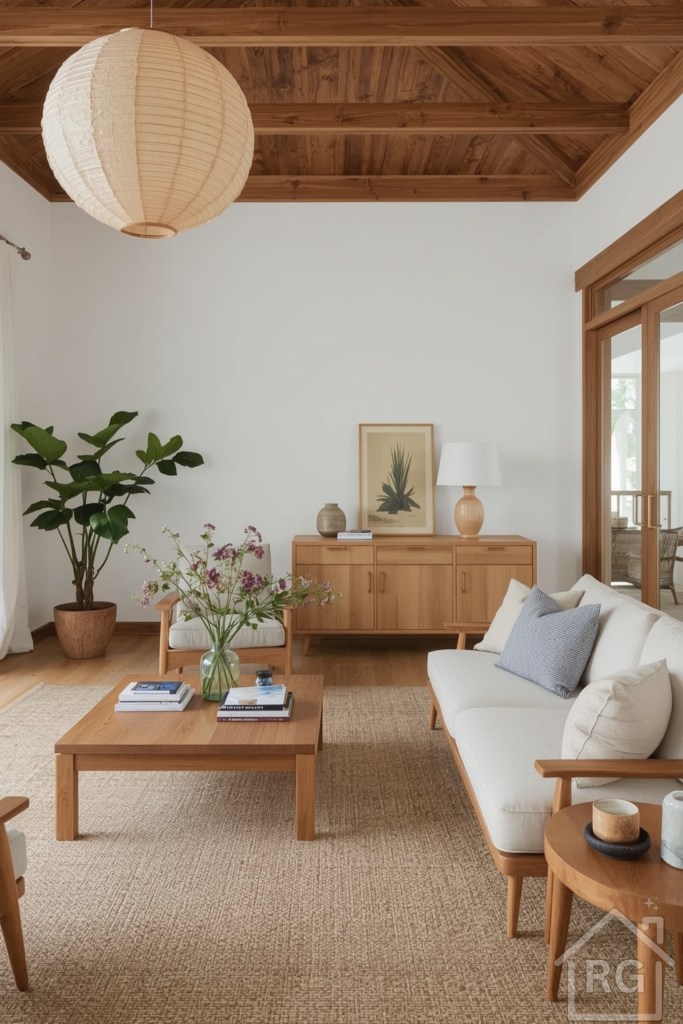
In Japandi interiors, furniture is an artful balance of form and function. Seek out pieces with clean lines and low profiles—a solid oak sofa frame with slender legs, a platform bed that seems to float, or a simple sideboard that doubles as display and storage. Scandinavian designers like Kaare Klint and Japanese classics such as the Tendo Mokko tenon table both exemplify this ethos. Choose upholstery in natural fabrics—linen, cotton, or lightly woven wool—and cushions in subdued tones. Opt for joinery details and craftsmanship over decorative flourishes, so each item stands as a testament to quality and intentional design.
Layout & Flow
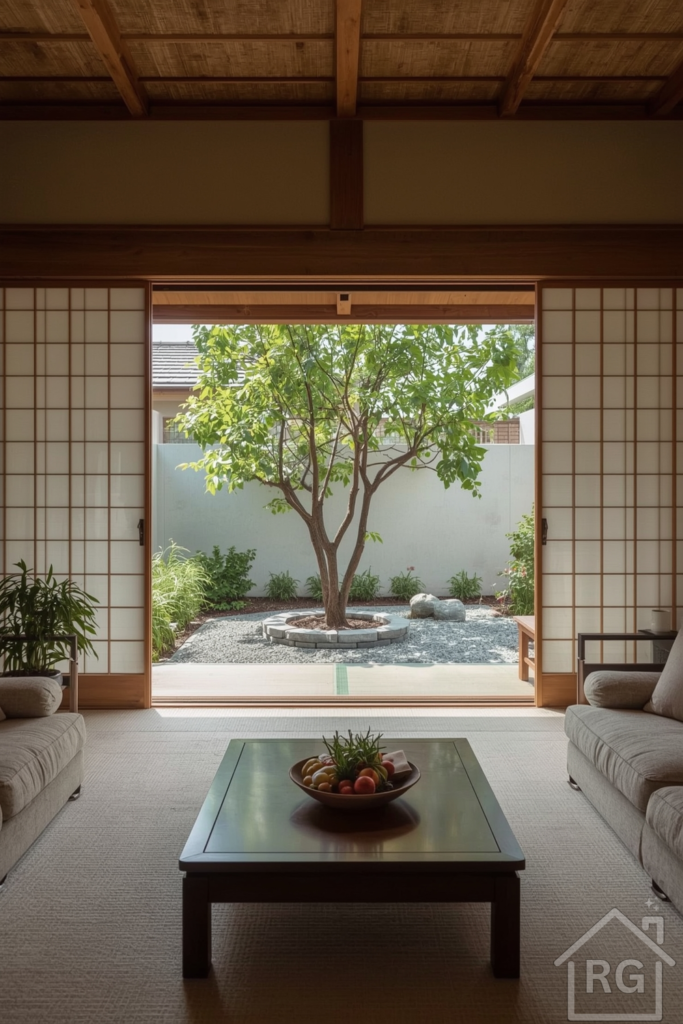
Space is as crucial as the objects within it. Japandi layouts emphasize negative space to allow furniture and décor to breathe. Position seating to foster conversation—two chairs angled toward each other or a sofa facing a low coffee table—while maintaining clear pathways for movement. Use open shelving, sliding shoji doors, or minimalist room dividers rather than bulky walls to define zones without obstructing sightlines. Keep floor plans uncluttered: resist the urge to fill every corner. This intentional spacing not only enhances calm but also amplifies natural light, making rooms feel larger and more serene.
Lighting
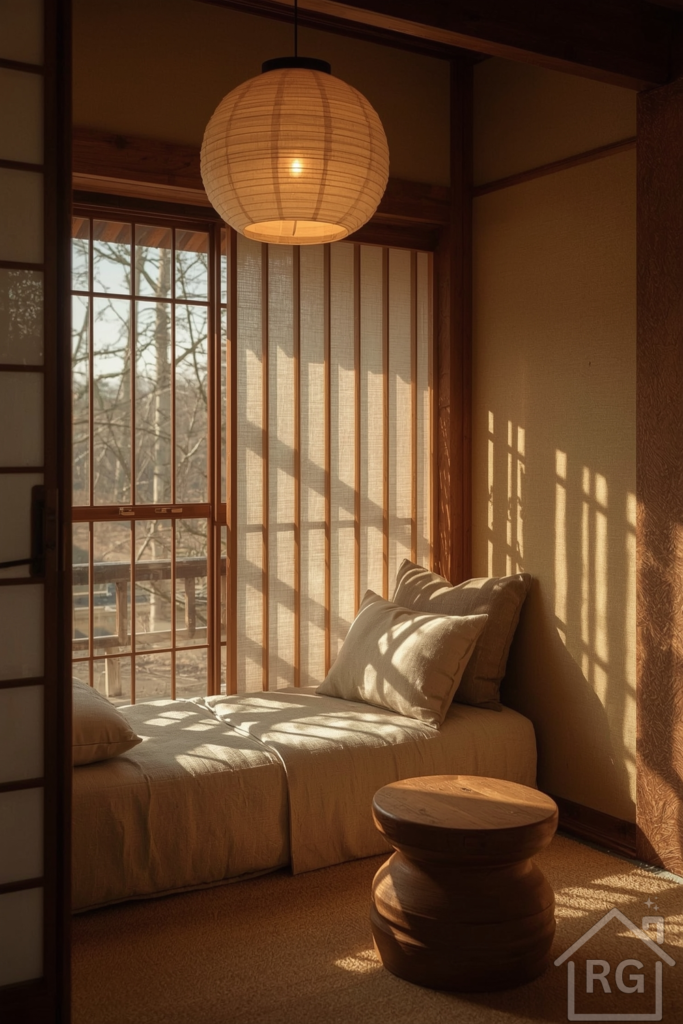
Lighting in Japandi design is all about softness and layering. Start with a central fixture—often a paper lantern or rice-paper shade—that diffuses light evenly. Complement it with floor or table lamps featuring natural materials like bamboo, wood, or ceramic bases paired with linen or paper shades. Wherever possible, maximize daylight: install sheer linen curtains or rice-paper screens to gently diffuse direct sun. In the evening, use warm-tone bulbs (around 2700K) to maintain a cozy ambiance. Strategic accent lighting—such as a small spotlight on a ceramic vase or a LED strip behind a shelf—can highlight textures without disrupting the overall softness.
Decor & Styling
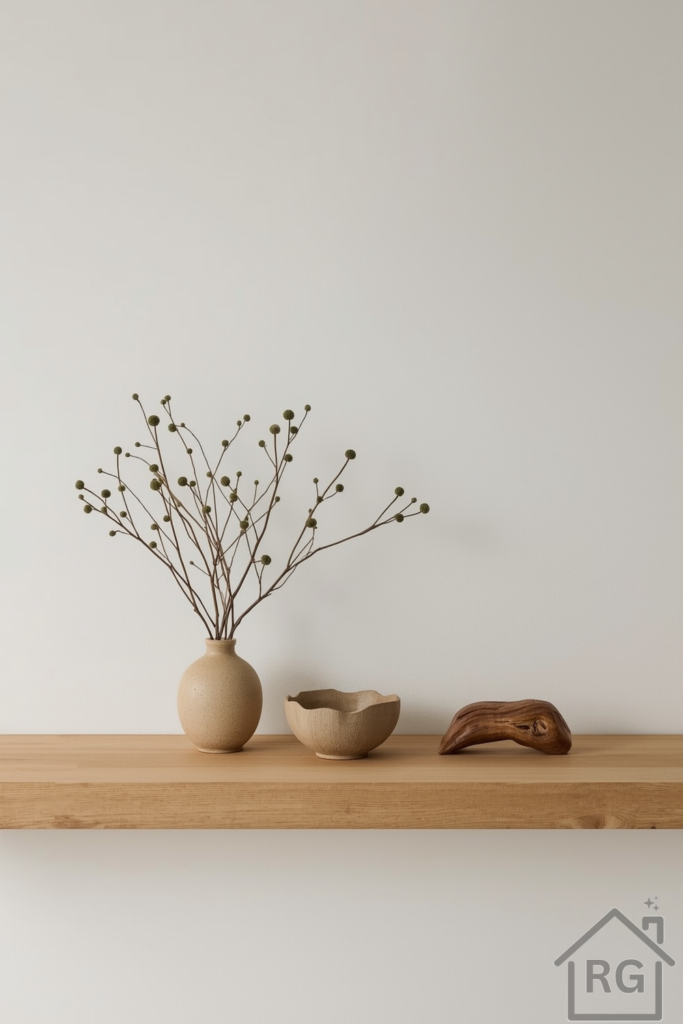
Decor in Japandi interiors is curated with restraint. Adopt a “less is more” mentality: display just three to five objects per vignette, each chosen for its craftsmanship or emotional resonance. A single ikebana-style floral arrangement in a handmade vase can become a focal point; a group of small, differently textured bowls communicates variety within unity. Vary heights and shapes—cluster a tall wooden sculpture next to a low ceramic dish—to create gentle visual rhythm. Keep color accents within your muted palette, and resist trends that conflict with Japandi’s timeless simplicity. This discipline ensures that every element feels intentional and meaningful.
IV. Room-by-Room Japandi Inspiration
Living Room
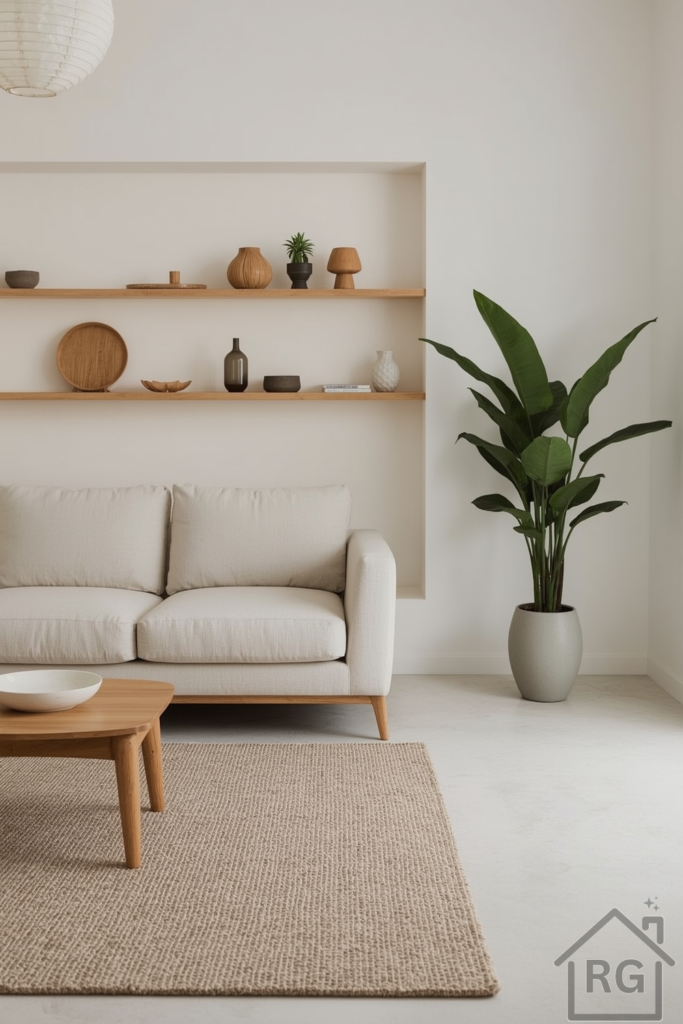
Transform your living room into a calming retreat by anchoring the space with a neutral linen sofa and a low oak coffee table. Layer a handwoven jute rug beneath to define the seating area and add tactile warmth underfoot. Place a sculptural indoor plant—such as a fiddle-leaf fig or monstera—in an unglazed ceramic planter to introduce organic form. Balance the composition with open shelving that displays just three to five well-loved ceramics or books, and finish with a paper-shade lantern overhead to cast soft, diffused light in the evening.
Kitchen
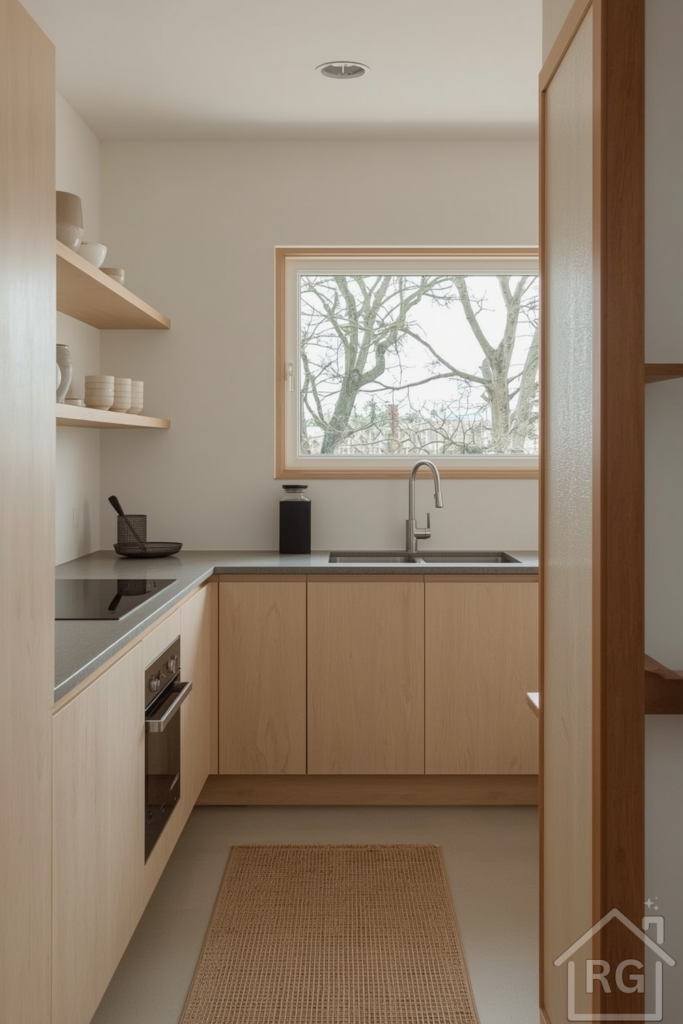
In a Japandi kitchen, simplicity meets functionality. Opt for pale wood cabinetry and floating shelves that showcase curated collections of stoneware bowls and matte-glazed mugs. Keep countertops clutter-free; store appliances behind closed doors or in a built-in pantry. Introduce a narrow woven runner—hemp or jute—down the center aisle for warmth and grounding. Position cooking utensils in a minimalist wooden caddy and hang a single artisan cutting board as both storage and art. A shoji-style window or rice-paper blinds will filter natural light and frame your culinary sanctuary.
Dining Room
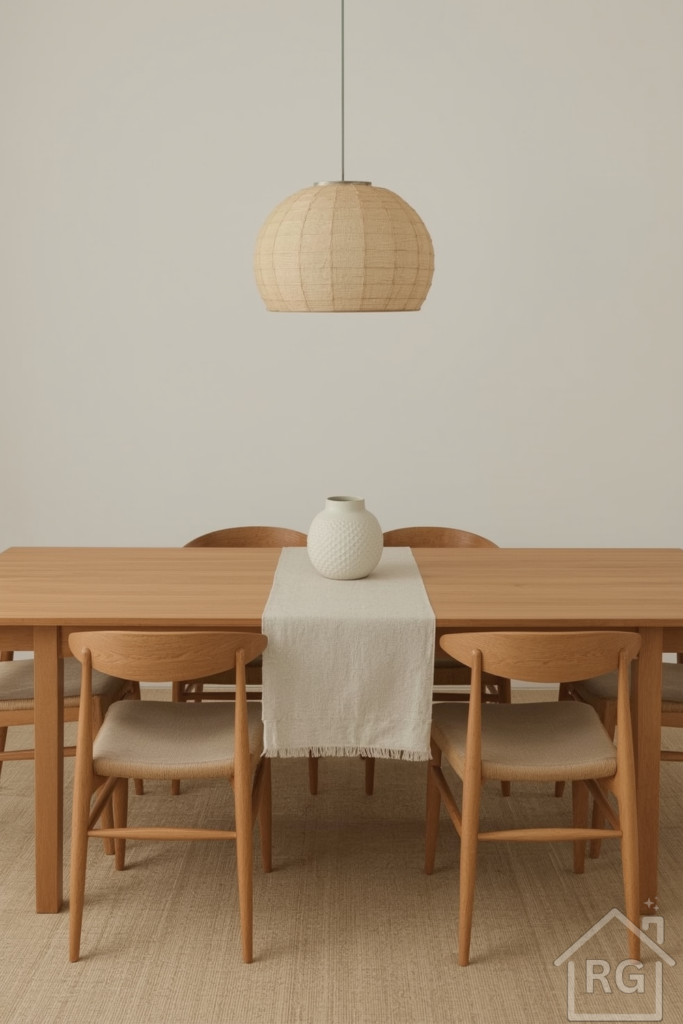
Create an intimate atmosphere around a low-profile oak dining table paired with Scandinavian-inspired chairs in muted fabric tones. Lay a natural linen runner to soften the wood grain, and place a handcrafted ceramic vase filled with a single branch or dried grasses at the center. Above, suspend a paper-shade pendant at just the right height—low enough for coziness but high enough to allow clear sightlines. Ground the arrangement with a round jute or sisal rug beneath, ensuring it’s large enough for chairs to remain on the rug when pulled out.
Bedroom
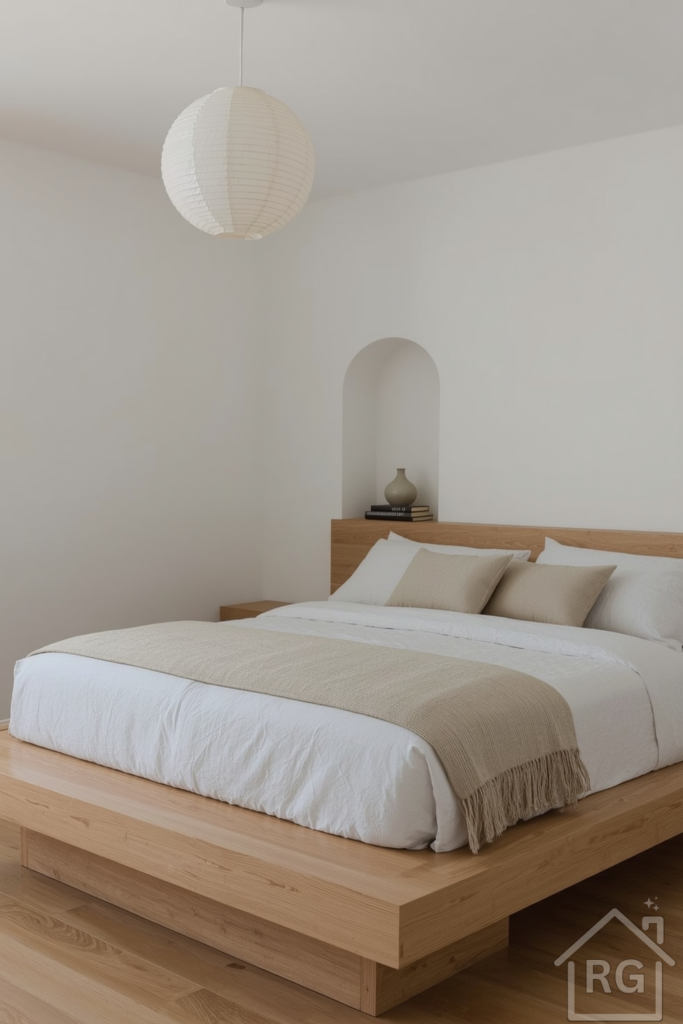
Design your bedroom as a sanctuary for rest. Choose a low, light-oak platform bed with built-in side ledges or floating nightstands to eliminate excess furniture. Dress the bed in layers of neutral linens—start with crisp cotton sheets, add a wool blanket, and finish with a linen duvet for texture. Position a paper lantern or wall-mounted rice-paper lamp for soft ambient light, and keep décor to a minimum: a single ikebana floral arrangement or a small stack of books on the night ledge. A subtle tatami mat underfoot can reinforce the Japanese influence.
Bathroom

Elevate your bathroom into a spa-like retreat by pairing a floating wooden vanity with a stone vessel sink. Use matte-black or brushed-bronze fixtures for a touch of contrast without overpowering the palette. Display only neatly folded bamboo-fiber towels and a single glass jar of natural soap or bath salts. A wooden stool can hold a simple ceramic planter with air plants or dried eucalyptus. Install frosted shoji-style panels or translucent curtains to diffuse incoming light and maintain privacy.
Home Office
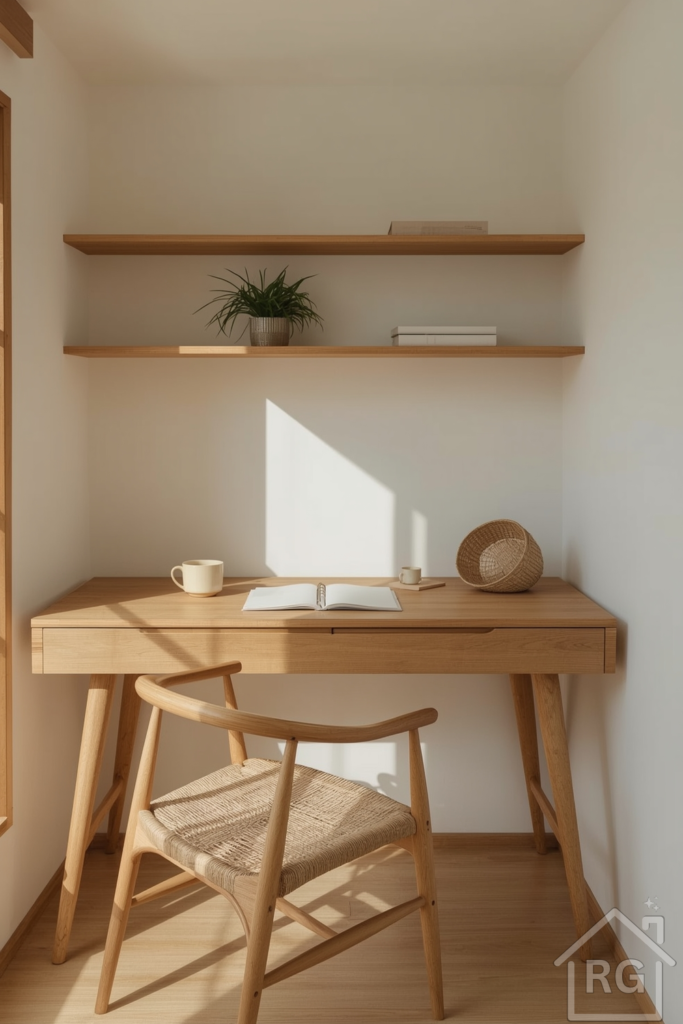
Cultivate productivity and calm in your home office with a slim wooden desk and a woven-seat chair. Keep the desktop clear—limit it to a ceramic pen cup, an open notebook with kraft-paper pages, and a small pot of succulents. Above, install a single floating shelf to hold reference books, a minimal lamp, and one decorative object. Position the desk near a window to follow natural light patterns, and use linen or cotton blinds to soften glare. A neutral-tone pinboard or wall grid can corral notes without visual clutter.
Entryway
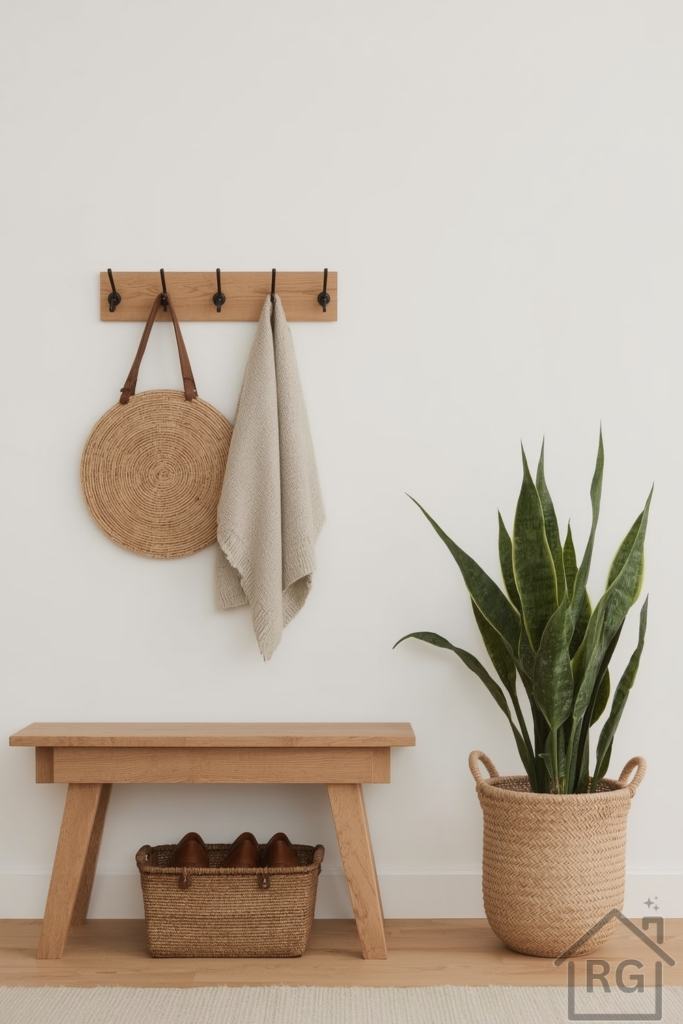
Set a tone of intentional simplicity in your entryway. A narrow oak bench provides seating and storage underneath—opt for woven baskets to hide shoes or scarves. Above, mount a minimalist peg rail to hold one coat or hat, keeping the look purposeful and uncluttered. Add a small, hand-thrown ceramic bowl to collect keys and loose change. Finish with a low-profile runner in a muted stripe or neutral weave to guide visitors through the threshold.
Balcony / Outdoor Space
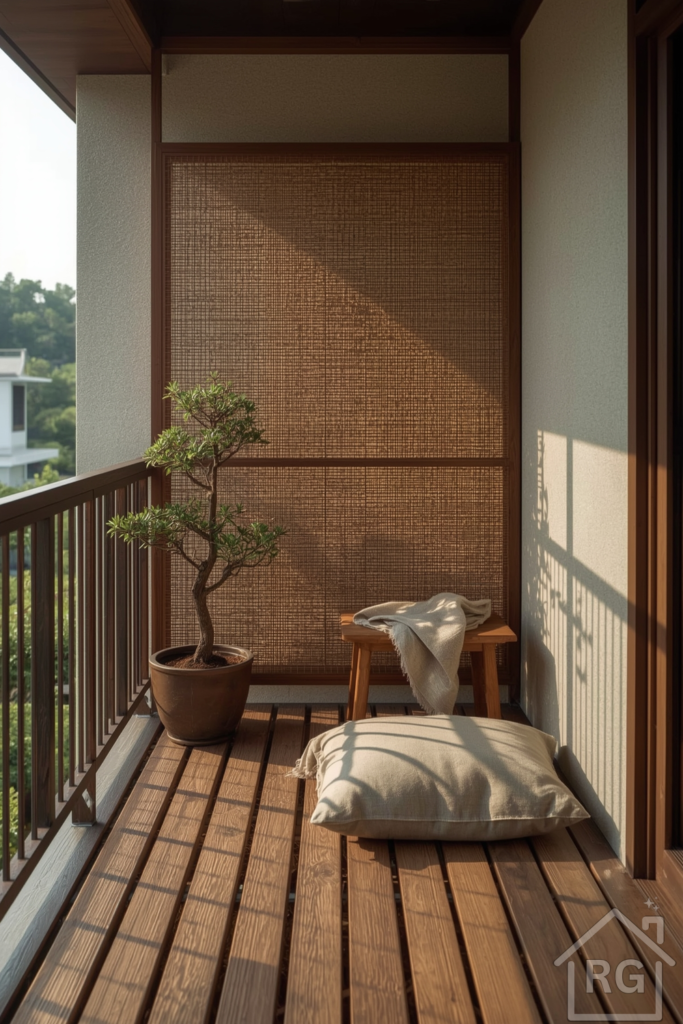
Extend Japandi tranquility outdoors with wood-slat decking or modular wooden tiles. Arrange floor cushions or a low bench around a simple teak or bamboo table for morning tea or evening reflection. Incorporate a potted bonsai or sculptural grasses in unglazed terracotta to connect with nature. A linen throw draped over seating adds comfort, while a bamboo screen or simple slatted railing maintains privacy without blocking light and breeze.
V. Japandi Styling Tips
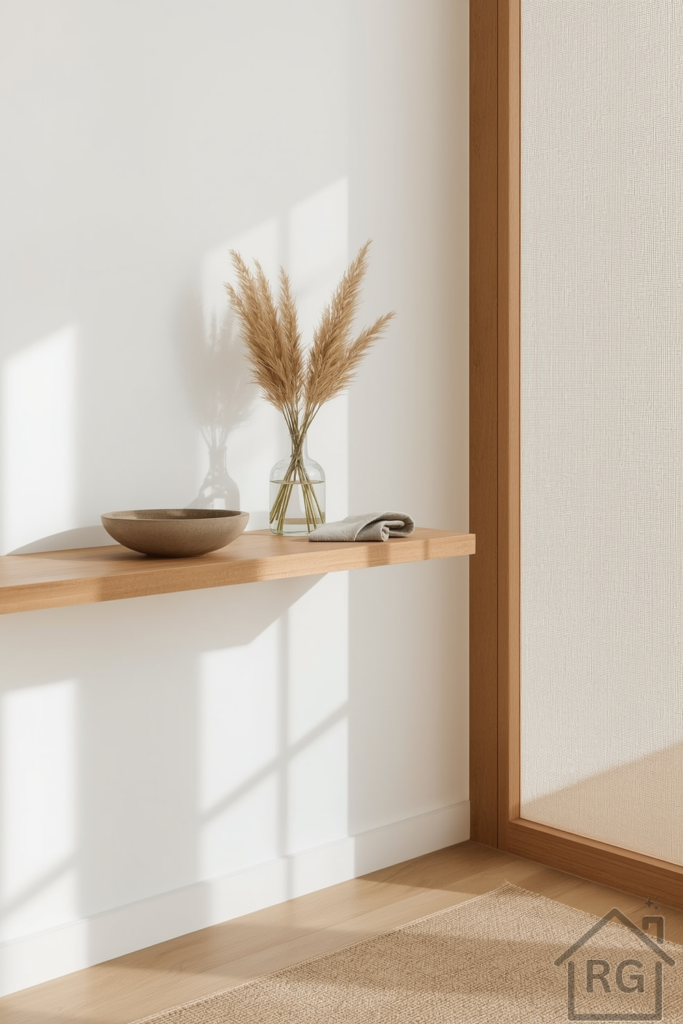
- Declutter with Purpose
Keep only what you love and use. Store rarely used items out of sight and rotate décor seasonally to maintain freshness without accumulating clutter. - Layer Natural Textures
Combine linen curtains, wool throws, jute rugs, and stone accents in each room. Textural contrast adds depth and warmth even within a restrained color palette. - Embrace Asymmetry
Arrange objects in odd-numbered groupings (three or five) and vary their heights. This creates gentle visual rhythm and avoids the formality of perfect symmetry. - Blend Cultural Pieces
Pair Scandinavian and Japanese elements—like a Muuto chair next to a vintage Japanese stool, or a Nordic wool rug layered over a tatami mat—to highlight each style’s strengths through thoughtful contrast. - Follow the Light
Position seating and work areas near windows. Use sheer linen or rice-paper screens to soften glare, and choose warm-tone bulbs (2700K–3000K) in lamps and overhead fixtures for evening ambiance.
VI. Common Mistakes to Avoid
- Over-Accessorizing
Filling shelves and tables with too many objects dilutes Japandi’s intentional calm. Stick to a few curated statement pieces per vignette. - Choosing Synthetic Imitations
Faux materials—like plastic-look wood or synthetic leather—lack the authenticity and patina of genuine wood, stone, or handcrafted ceramics. Invest in real materials, even if only one quality piece. - Mixing Incongruent Styles
Industrial, maximalist, or glam accents can clash with Japandi’s ethos. Ensure every addition reinforces simplicity, warmth, and natural harmony. - Neglecting Scale and Proportion
Low-profile furniture must suit the room’s dimensions. Oversized rugs or tall décor elements can disrupt the intended flow and sense of openness.
Conclusion
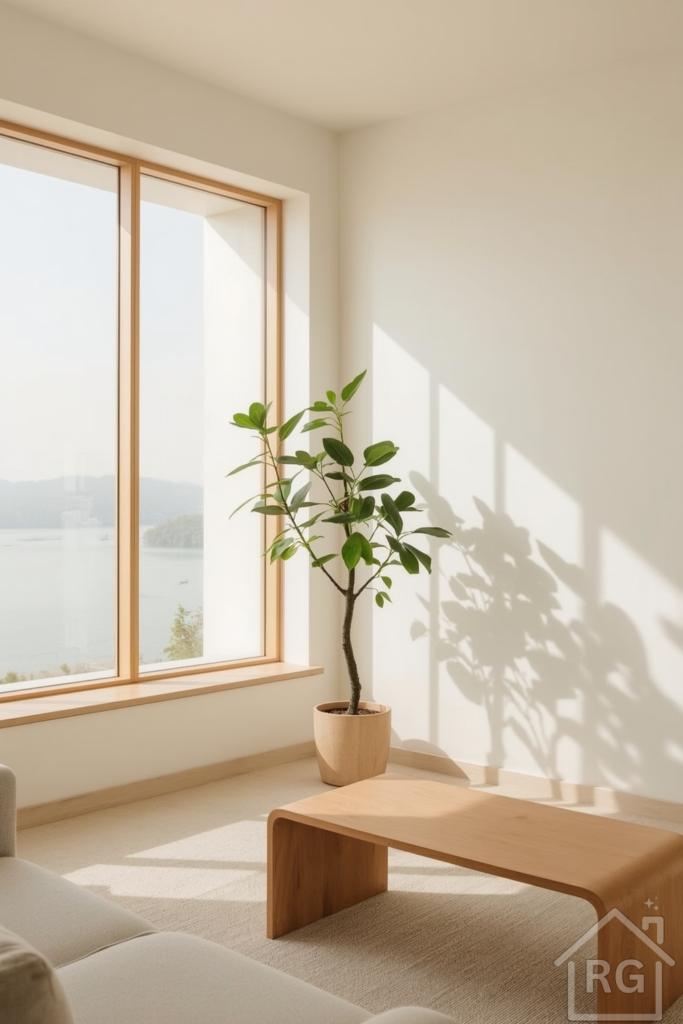
Japandi style invites us to live simply, mindfully, and beautifully. By prioritizing natural materials, a muted color palette, and uncluttered layouts, you can craft interiors that reduce stress and enhance well-being. Start small—perhaps with a linen throw on your sofa or a hand-thrown ceramic vase on your shelf—and let each intentional choice guide you toward a home defined by harmony and warmth. For more inspiration, explore our Ultimate Wabi-Sabi Aesthetic and Modern Minimalist Interiors guides.
